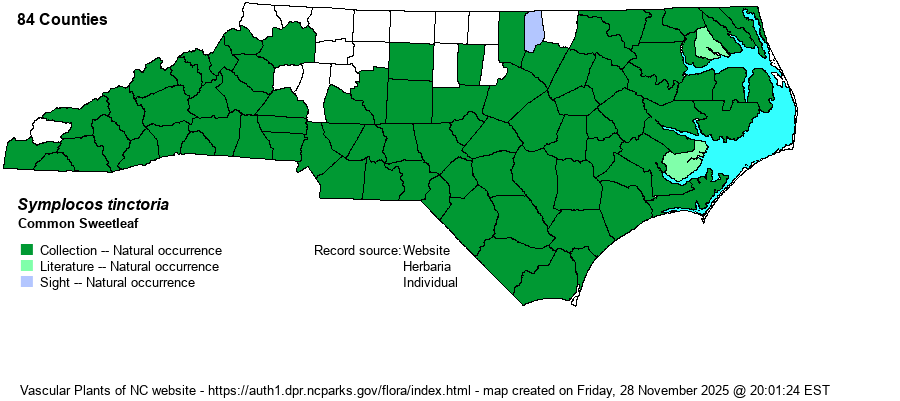| Author | (L.) L'Heritier | |
| Distribution | Throughout the Coastal Plain, and over much of the Piedmont, though seemingly absent in the north-central and northwestern portions (between Granville, Randolph, and Wilkes counties). Present throughout the Mountains except absent from the northern tier of counties (Ashe and Alleghany). The gap in much of the northern half of the Piedmont is a bit odd, but is certainly real.
This is a Southern species ranging north only to DE, eastern VA, and eastern OK, south to northern FL and eastern TX.
| |
| Abundance | Frequent to common in the Coastal Plain; frequent in the southeastern Piedmont. Much less numerous in the Mountains and western Piedmont, where mainly uncommon though widespread. | |
| Habitat | The habitats of this species are widespread but difficult to categorize. It favors damp yet sandy soils. But, it is found along pocosin margins, steamhead pocosins, some bottomland forests, a variety of mesic forests, and even on bluffs and ridges! It is widespread in sandhills forests, though normally not in deep sands. For example, at Hemlock Bluffs in Wake County, it grows on steep bluffs “in place of” Mountain Laurel (Kalmia latifolia), which is surprisingly absent there! It tends to favor pine-dominated sites and is scarce under a hardwood canopy. |
| Phenology | Blooms from March to May, and fruits in August and September. | |
| Identification | This is a familiar semi-evergreen (tardily deciduous) small tree or large shrub, growing to about 20-30 feet tall, occasionally taller. The leaves are dark green, and become almost blackish above by winter, though they tend to remain on the stems for much of the winter (more so in the Coastal Plain). They are alternate, elliptic to more often obovate to oblanceolate (wider above the middle), entire, thick (coriaceous) and shiny above. Some people confuse this species with Mountain Laurel, but that species has shorter and more elliptical leaves. Normally, Symplocos will show buds, flowers, or capsules along the stems during the growing season. When in bloom, it is unique – an abundance of pale yellow flowers along the stems, with most of the color coming from the many yellowish stamens (and thus appearing to have no petals). The flowers appear in early spring either as old leaves hang on the branches, or before the new leaves have emerged. | |
| Taxonomic Comments | None, though some older references listed varieties for the species. Most now do not.
| |
| Other Common Name(s) | Horse-sugar (or Horse Sugar), Sweetleaf | |
| State Rank | S5 | |
| Global Rank | G5 | |
| State Status | | |
| US Status | | |
| USACE-agcp | FAC link |
| USACE-emp | FAC link |

